Researchers in Germany and the U.S. have shown for the first time that terahertz (THz) light pulses can stabilize ferromagnetism in a crystal at temperatures more than three times its usual transition temperature. As the team reports in Nature, using pulses just hundreds of femtoseconds long (a millionth of a billionth of a second), a ferromagnetic state was induced at high temperature in the rare-earth titanate YTiO3 which persisted for many nanoseconds after the light exposure. Below the equilibrium transition temperature, the laser pulses still strengthened the existing magnetic state, increasing the magnetization up to its theoretical limit.
Using light to control magnetism in solids is a promising platform for future technologies. Today’s computers mainly rely on the flow of electrical charge to process information. Moreover, digital memory storage devices make use of magnetic bits that must be switched external magnetic fields. Both of these aspects limit the speed and energy efficiency of current computing systems. Using light instead to optically switch memory and computing devices could revolutionize processing speeds and efficiency.
YTiO3 is a transition metal oxide that only becomes ferromagnetic, with properties resembling those of a fridge magnet, below 27 K or −246°C. At these low temperatures, the spins of the electrons on the Ti atoms align in a particular direction. It is this collective ordering of the spins which gives the material as a whole a macroscopic magnetization and turns it ferromagnetic. In contrast, at temperatures above 27 K, the individual spins fluctuate randomly so that no ferromagnetism develops.
